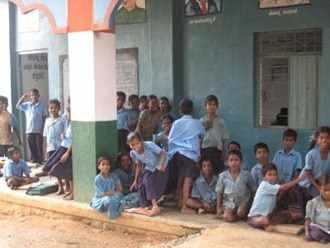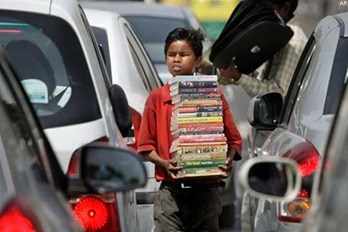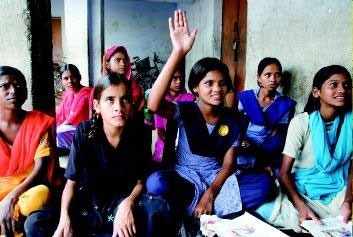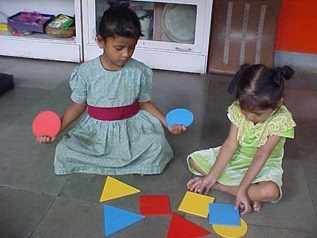Case Study: 3 Challenges of Indian Education System
Indian education during ancient times traditionally followed this maxim underlined in the Katha Upanishad but with the passage of time the system has undergone gradual changes.
A Background to Indian Education
Indian education during ancient times traditionally followed this maxim underlined in the Katha Upanishad but with the passage of time the system has undergone gradual changes. In post-Independent India, the aim of education has been elaborately stated by various education commissions but unfortunately it has turned out to produce a new careerist class without any consideration for ethical and national spirit. The word education is derived from Latin word ‘educare’ meaning to draw out, to foster growth and to develop. Ancient education at the gurukuls, away from the worldly pursuits, aimed at imbibing scholarship and mental development. However the arrival of the Mughals in the 10 th century changed the face of education and after the establishment of the British Raj the system underwent another drastic change. Macaulay’s minutes and introduction of English education in India dealt a blow to the age old Vedic education as it became less important and English occupied the most prominent role. It changed the entire system of education in India. This system tended to establish a thoroughly English educational system to create a class of persons that were Indian by race and colour but English in taste, morals and intellect. After independence our policy makers laid down certain basic functions of education suited to the immediate needs of that time. These provisions have been revised time and again according to the need of the society. In spite of various efforts over the decades, India’s educational structure could not eradicate the problems of illiteracy and even now, there is a need for such missions that can arouse awareness about the importance of education among the masses. Even after more than 60 years of independence, we find ourselves unable to achieve our decided objectives due to various reasons. Lack of awareness and an obsolete mentality about the system has resulted in poor growth of education amongst masses. Nevertheless, we have highly reputed IITs and IIMs in our country but at the same time, a majority of children in rural areas are devoid of a formal education.
In post-Independent India, the aim of education has been elaborately stated by various education commissions but unfortunately it has turned out to produce a new careerist class without any consideration for ethical and national spirit. The word education is derived from Latin word ‘educare’ meaning to draw out, to foster growth and to develop. Ancient education at the gurukuls, away from the worldly pursuits, aimed at imbibing scholarship and mental development. However the arrival of the Mughals in the 10 th century changed the face of education and after the establishment of the British Raj the system underwent another drastic change. Macaulay’s minutes and introduction of English education in India dealt a blow to the age old Vedic education as it became less important and English occupied the most prominent role. It changed the entire system of education in India. This system tended to establish a thoroughly English educational system to create a class of persons that were Indian by race and colour but English in taste, morals and intellect. After independence our policy makers laid down certain basic functions of education suited to the immediate needs of that time. These provisions have been revised time and again according to the need of the society. In spite of various efforts over the decades, India’s educational structure could not eradicate the problems of illiteracy and even now, there is a need for such missions that can arouse awareness about the importance of education among the masses. Even after more than 60 years of independence, we find ourselves unable to achieve our decided objectives due to various reasons. Lack of awareness and an obsolete mentality about the system has resulted in poor growth of education amongst masses. Nevertheless, we have highly reputed IITs and IIMs in our country but at the same time, a majority of children in rural areas are devoid of a formal education. Literacy Trend in India
The latest figures reveal the increasing trend in literacy ratio but it also depicts the vast differences between rural and urban literacy growth rate. With around 296 million illiterate citizens above the age of seven, the government has initiated various programs and missions for the quantitative expansion of education. As a country, India’s main objective is to become a major challenge to global powers in this sphere. Free and compulsory education to all children up to the age of fourteen is the constitutional commitment in India. UNESCO also aims at education for all by 2015 but our country is one among those where the literacy levels are much lower than other countries and requires gigantic efforts to reach the globally decided level of 75%. The Indian education system is perhaps the second largest in the world catering students from different socio-economic background. At the time of independence, emphasis was on the quantitative expansion of the education facilities which tilted to quality education after the 1960’s. However, in the present decade, the government has been trying to spread education to the most remote parts of the country with the help of various schemes to attract children residing in rural areas to attend school such as the Midday Meal Scheme, Sarva Shiksha Abhiyan (Education for All) etc. These schemes have been initiated keeping in view of the goal of cent percent literacy ratio. The statistics shows that gross enrolment ratio at present is about 90% at primary level and only 60% at secondary level. This reveals that still many youngsters are out of school and not getting the required education that can foster these individuals as well as national development. A few states have attained the goal of universal primary/ elementary education but many have yet to realize this target. The National Policy on Education , 1986 stressed universalization of elementary education as the top priority but despite mammoth efforts by the authorities, there are about 50-60 million children in the age group of 6 to 14 years who are deprived of primary school education. Apart from accessibility problems, social and economic factors are significantly responsible for this problem. Poor infrastructural facilities in schools under public sector and exorbitant fees in schools under private sector add to the high rate of students who dropout from school before completing primary education. Consequently, urgent measures are required to control the rate of dropouts and expand education to all.
As a country, India’s main objective is to become a major challenge to global powers in this sphere. Free and compulsory education to all children up to the age of fourteen is the constitutional commitment in India. UNESCO also aims at education for all by 2015 but our country is one among those where the literacy levels are much lower than other countries and requires gigantic efforts to reach the globally decided level of 75%. The Indian education system is perhaps the second largest in the world catering students from different socio-economic background. At the time of independence, emphasis was on the quantitative expansion of the education facilities which tilted to quality education after the 1960’s. However, in the present decade, the government has been trying to spread education to the most remote parts of the country with the help of various schemes to attract children residing in rural areas to attend school such as the Midday Meal Scheme, Sarva Shiksha Abhiyan (Education for All) etc. These schemes have been initiated keeping in view of the goal of cent percent literacy ratio. The statistics shows that gross enrolment ratio at present is about 90% at primary level and only 60% at secondary level. This reveals that still many youngsters are out of school and not getting the required education that can foster these individuals as well as national development. A few states have attained the goal of universal primary/ elementary education but many have yet to realize this target. The National Policy on Education , 1986 stressed universalization of elementary education as the top priority but despite mammoth efforts by the authorities, there are about 50-60 million children in the age group of 6 to 14 years who are deprived of primary school education. Apart from accessibility problems, social and economic factors are significantly responsible for this problem. Poor infrastructural facilities in schools under public sector and exorbitant fees in schools under private sector add to the high rate of students who dropout from school before completing primary education. Consequently, urgent measures are required to control the rate of dropouts and expand education to all. Quality Education is Real Education
But expansion by itself will not serve the purpose of dream India. Quantity without quality has no significance. Therefore, it is also necessary to achieve excellence in education that can generate quality professionals and executives. The main problem that persists in today’s milieu is degrading higher education. On the one hand, children are not getting facilities of education in rural areas while on the other, the affluent section of the population is sending their children to private schools where money reciprocates passing marks and no attention is paid towards properly grooming the student. These private schools are nothing but business centers that are interested in minting money. Not surprisingly, the level of education is very low due to untrained and ill paid teachers and there is no stress on practical information and selected syllabus coverage. The trend being followed these days is to cram the selected chapters or sometimes even selected questions and then to “regurgitate” them in the answer sheets to get good marks. In this manner, a graduate or a professional is generated without any actual learning and they face problems in earning livelihood later in life. The alarming number of unemployed people in India has posited a question mark before the policy makers. This will ultimately result in emergence of a new Babuji class– a group who is educated on paper but is devoid of any compatibility and excellence. Such youngsters expect high package salaries and their failure in the competitive market is responsible for increasing suicide rates and decline in availability of labour force. Thus achieving excellence in imparting education should be our top priority. There is no denying the fact that India has achieved excellence in the fields of science and technology by generating great scientists such as Dr. APJ Abdul Kalam. But the need of the hour is to achieve the same level of excellence at all the stages. We are proud of our achievements in space technology, nuclear energy missiles and other weapons, medical etc. but the other sectors still have to make earnest efforts to match the status of these fields. Our human resource potential can be utilized in the best possible manner if quantitative education is clubbed with qualitative education. It is then that our country will have renowned centers of learning in the present age on the lines of the institutes of previous ages such as Nalanda and Taxila. Our IIM’s and IIT’s are well known for their quality education but many institutions have not yet achieved the bare minimum. Their educational standards are below average in the spheres of infrastructure, teaching staff, clarity in examination and admission. Since most of these institutions are controlled by private entrepreneurs, their aim is to extort fees and make maximum profit. Thus excellence can only be achieved by inspecting these institutes on a regular basis as well as maintaining a uniform pattern of selection and salary for faculty. This will certainly help in reaching the set goals.
professionals and executives. The main problem that persists in today’s milieu is degrading higher education. On the one hand, children are not getting facilities of education in rural areas while on the other, the affluent section of the population is sending their children to private schools where money reciprocates passing marks and no attention is paid towards properly grooming the student. These private schools are nothing but business centers that are interested in minting money. Not surprisingly, the level of education is very low due to untrained and ill paid teachers and there is no stress on practical information and selected syllabus coverage. The trend being followed these days is to cram the selected chapters or sometimes even selected questions and then to “regurgitate” them in the answer sheets to get good marks. In this manner, a graduate or a professional is generated without any actual learning and they face problems in earning livelihood later in life. The alarming number of unemployed people in India has posited a question mark before the policy makers. This will ultimately result in emergence of a new Babuji class– a group who is educated on paper but is devoid of any compatibility and excellence. Such youngsters expect high package salaries and their failure in the competitive market is responsible for increasing suicide rates and decline in availability of labour force. Thus achieving excellence in imparting education should be our top priority. There is no denying the fact that India has achieved excellence in the fields of science and technology by generating great scientists such as Dr. APJ Abdul Kalam. But the need of the hour is to achieve the same level of excellence at all the stages. We are proud of our achievements in space technology, nuclear energy missiles and other weapons, medical etc. but the other sectors still have to make earnest efforts to match the status of these fields. Our human resource potential can be utilized in the best possible manner if quantitative education is clubbed with qualitative education. It is then that our country will have renowned centers of learning in the present age on the lines of the institutes of previous ages such as Nalanda and Taxila. Our IIM’s and IIT’s are well known for their quality education but many institutions have not yet achieved the bare minimum. Their educational standards are below average in the spheres of infrastructure, teaching staff, clarity in examination and admission. Since most of these institutions are controlled by private entrepreneurs, their aim is to extort fees and make maximum profit. Thus excellence can only be achieved by inspecting these institutes on a regular basis as well as maintaining a uniform pattern of selection and salary for faculty. This will certainly help in reaching the set goals. Ways to Achieve Higher Literacy Rate: Reduction in Drop-out Rate
Primary education must be compulsory and as such, the expansion of education up to middle or secondary level is comprehensible. But today, Indian cities and villages are flooded with universities and colleges which are not providing the higher levels of education. The need of the hour is to impart basic education to all and higher education should be kept for deserving candidates who really want to excel. Only degree and badge earners would not benefit our country. It puts a question mark on aspiring and budding minds. However, achieving excellence should not be taken to mean exclusion from education. The dropout rate should not show an increasing trend. Otherwise the whole system of education would shatter away like sand castle. Thus inclusion is also a major challenge confronting Indian educationists and policy makers. Across the subcontinent 90% of India’s estimated 40 million children aged 4-16 years with physical and mental disabilities are out of school. And the overwhelming majority of them are vagabonds not out of volition, but because callous school management and over anxious parents of able children in a travesty of humanity and social justice have consistently discouraged them from entering the nations’ classrooms. Social justice and equity which are predominantly embedded in the Constitution of India demand that India’s 35 million physically challenged, if not 5 million mentally handicapped should be given preferential access into primary and secondary schools. These children too have right to education. Then why are they excluded sometimes systematically and intentionally? This is an ultimate reality about an uncaring society of hypocrites and selfish people.
But today, Indian cities and villages are flooded with universities and colleges which are not providing the higher levels of education. The need of the hour is to impart basic education to all and higher education should be kept for deserving candidates who really want to excel. Only degree and badge earners would not benefit our country. It puts a question mark on aspiring and budding minds. However, achieving excellence should not be taken to mean exclusion from education. The dropout rate should not show an increasing trend. Otherwise the whole system of education would shatter away like sand castle. Thus inclusion is also a major challenge confronting Indian educationists and policy makers. Across the subcontinent 90% of India’s estimated 40 million children aged 4-16 years with physical and mental disabilities are out of school. And the overwhelming majority of them are vagabonds not out of volition, but because callous school management and over anxious parents of able children in a travesty of humanity and social justice have consistently discouraged them from entering the nations’ classrooms. Social justice and equity which are predominantly embedded in the Constitution of India demand that India’s 35 million physically challenged, if not 5 million mentally handicapped should be given preferential access into primary and secondary schools. These children too have right to education. Then why are they excluded sometimes systematically and intentionally? This is an ultimate reality about an uncaring society of hypocrites and selfish people. Inclusive Education: A New Concept
 Against the backdrop of continuous neglect to develop the educational potential of these children, the “North South Dialogue II on Inclusive Education: From Rhetoric to Reality” was convened in Kochi which calls upon governments around the world to recognize and enforce the right of disabled children to be included in mainstream education institutions. This will certainly result in their acceptance into the society. How could a nation afford to waste vast human potential? The need is to understand the fact that these people could be highly contributing to the growth of the nation. Though a borrowed concept, the inclusive education has been successfully tried. A focused programme for community development, teacher training and public awareness has brought about dramatic changes in the outlook of all the sections of the society- parents, teachers and peers. The times and attitudes are changing, albeit slowly. However, the enlightened managements of some mainstream schools across the country are waking up to the need and advantages of inclusive education. For promoting this the government and the management must look upon the infrastructural facilities required for these students, for most of the time inaccessible buildings or uncomfortable furniture is responsible for this exclusion. Even the 86 th amendment act of the Indian Constitution re-establishes the meaning of free and compulsory education to all children up to the age of 14 years – even the disabled. Inclusive education is gaining ground. Throughout the world teachers and others involved in education are working to develop positive educational experiences that all children and young people can enjoy and benefit from together. Inclusion of dropouts due to lack of encouragement and positive attitude towards education is the prime duty of the educationists and the policy makers. The fate of an Indian person who is disabled does not fall within the purview of the education ministry. It is the burden of the omnibus ministry of social justice and empowerment. The system of establishing special schools promotes isolation, alienation and social exclusion. It is this dominant attitude of exclusion which needs to be changed to build harmonious and compassionate society. The drive towards inclusion is not only rhetoric; rather the reality of inclusive education is transforming the lives of millions of children and teachers in countries across the world. According to the OECD Report, there is a decline in the proportion of students in special school in most countries. CSIE’s Index for Inclusion, which helps ordinary schools to break down the barriers of learning and participation, is being taken up in a range of countries around the world. Despite the significant advances however, large number of disabled children and young continue to be subjected to negative approach and exclusion from mainstream education. It’s high time now to revise the education policy so that it can face the major challenges of expansion, excellence and inclusion. All are important for the planned growth of our country. Expansion and inclusion are close to each other. The objective is to provide educational facilities to maximum number including the challenged whereas excellence deals with the qualitative aspect of the education. Progress needs to happen on all fronts- quantity as well as quality. India must build on its new education policy on the basis of experience gained in the post independence era. Non government organizations and individuals must also continue to lobby governments and raise awareness among the masses about the importance of education. With proper laws and strict implementation India can once again be at the apex of education. Our universities can stand above Cambridge, Oxford, Michigan and other globally reputed universities. Therefore, the policy makers should rise above narrow political differences to accept these challenges and change the face of our country through education.
Against the backdrop of continuous neglect to develop the educational potential of these children, the “North South Dialogue II on Inclusive Education: From Rhetoric to Reality” was convened in Kochi which calls upon governments around the world to recognize and enforce the right of disabled children to be included in mainstream education institutions. This will certainly result in their acceptance into the society. How could a nation afford to waste vast human potential? The need is to understand the fact that these people could be highly contributing to the growth of the nation. Though a borrowed concept, the inclusive education has been successfully tried. A focused programme for community development, teacher training and public awareness has brought about dramatic changes in the outlook of all the sections of the society- parents, teachers and peers. The times and attitudes are changing, albeit slowly. However, the enlightened managements of some mainstream schools across the country are waking up to the need and advantages of inclusive education. For promoting this the government and the management must look upon the infrastructural facilities required for these students, for most of the time inaccessible buildings or uncomfortable furniture is responsible for this exclusion. Even the 86 th amendment act of the Indian Constitution re-establishes the meaning of free and compulsory education to all children up to the age of 14 years – even the disabled. Inclusive education is gaining ground. Throughout the world teachers and others involved in education are working to develop positive educational experiences that all children and young people can enjoy and benefit from together. Inclusion of dropouts due to lack of encouragement and positive attitude towards education is the prime duty of the educationists and the policy makers. The fate of an Indian person who is disabled does not fall within the purview of the education ministry. It is the burden of the omnibus ministry of social justice and empowerment. The system of establishing special schools promotes isolation, alienation and social exclusion. It is this dominant attitude of exclusion which needs to be changed to build harmonious and compassionate society. The drive towards inclusion is not only rhetoric; rather the reality of inclusive education is transforming the lives of millions of children and teachers in countries across the world. According to the OECD Report, there is a decline in the proportion of students in special school in most countries. CSIE’s Index for Inclusion, which helps ordinary schools to break down the barriers of learning and participation, is being taken up in a range of countries around the world. Despite the significant advances however, large number of disabled children and young continue to be subjected to negative approach and exclusion from mainstream education. It’s high time now to revise the education policy so that it can face the major challenges of expansion, excellence and inclusion. All are important for the planned growth of our country. Expansion and inclusion are close to each other. The objective is to provide educational facilities to maximum number including the challenged whereas excellence deals with the qualitative aspect of the education. Progress needs to happen on all fronts- quantity as well as quality. India must build on its new education policy on the basis of experience gained in the post independence era. Non government organizations and individuals must also continue to lobby governments and raise awareness among the masses about the importance of education. With proper laws and strict implementation India can once again be at the apex of education. Our universities can stand above Cambridge, Oxford, Michigan and other globally reputed universities. Therefore, the policy makers should rise above narrow political differences to accept these challenges and change the face of our country through education. The author is holding PhD from Department of English, M.L.S.U, Udaipur. She is working as an assistant professor in one of the reputed colleges of Udaipur.
To join us on Facebook Click Here and Subscribe to UdaipurTimes Broadcast channels on GoogleNews | Telegram | Signal


